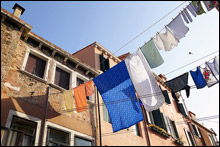Dear Umbra,
We would like to install a clothesline this summer to take advantage of the few months of sun that we get here in Oregon. Any advice on the best kind, and how to keep air-dried clothes from feeling like cardboard?
German Whitley
Philomath, Ore.
Dearest German,
Excellent. If your power supplier is, as I suspect, Consumers Power Inc. in Philomath, you are paying about 7 cents per kilowatt-hour; their handy electricity calculator says drying five loads of laundry a week is costing you $56 per year. So, besides reducing demand on the electric grid, drying your clothes outside will save you money.

They call me the launderer.
Once you’ve made the decision to line dry, most of the rest of your choices surround utility, cost, and aesthetics. The No. 1 consideration must be your outdoor space: its dimensions, location, and availability of line-stringing spots. You must choose between a plain old line strung between two points (via the shortest distance, of course) and a freestanding umbrella-type folding clothesline.
Check out Project Laundry List for shopping tips and links. The classic clothesline (with hooks, about $10) usually comes in cotton, cotton/poly, nylon-coated wire, or vinyl-coated wire. Here is where one eco-tip comes in: no vinyl, and that’s final.
If you have a small space or a wide space with no contact points, an umbrella-type line — which costs about $55 — might be best. These can be folded up and kept in the garage during the rainy season, and you may get more linear drying feet in your particular alfresco zone.
Oh, crunchy dungarees are the worst. Some suggestions for reducing stiffness: use less detergent (a good idea in any case), snap out the wrinkles when hanging the clothes, hang in a partially shady spot, hang on windy days (see if you can set up your system to take advantage of prevailing winds), and position clothes with the heavy part on the bottom (e.g., pants with belt loops down).
Finally, for ultimate laundry efficiency: think about moving to the desert.
Freshly,
Umbra

